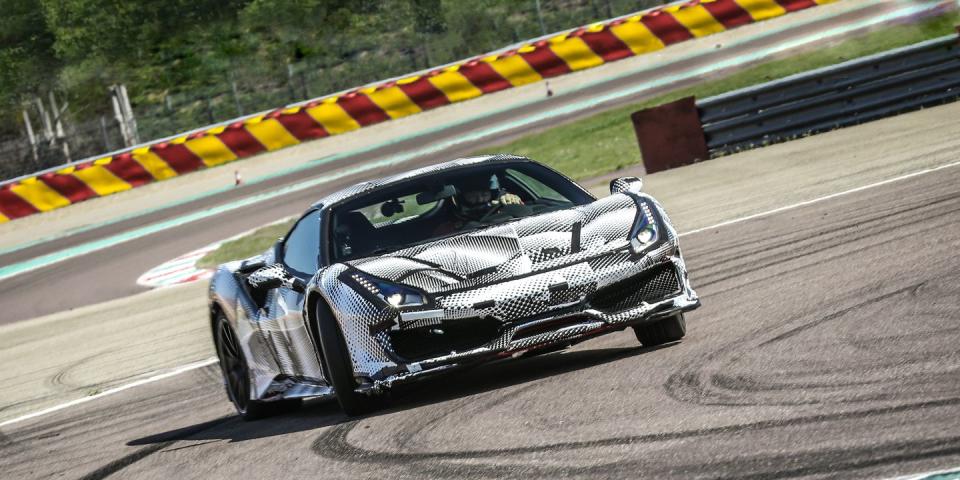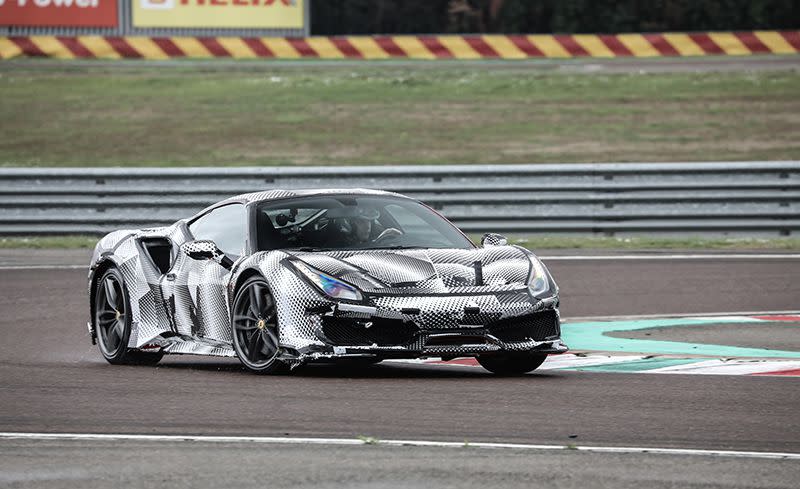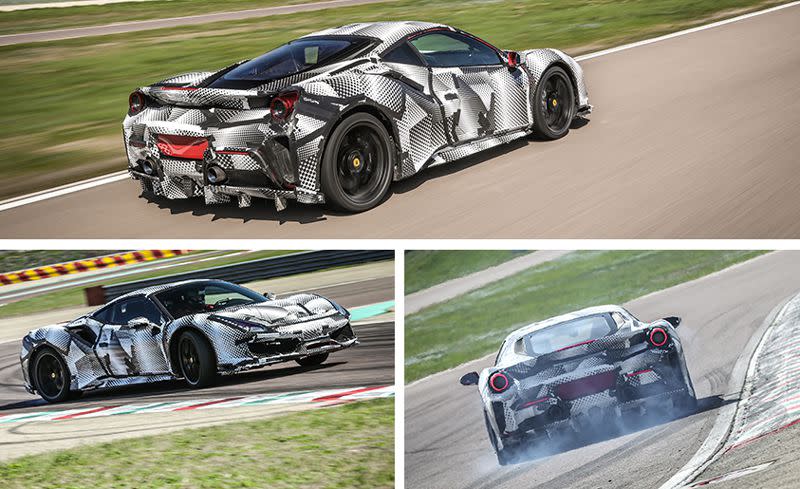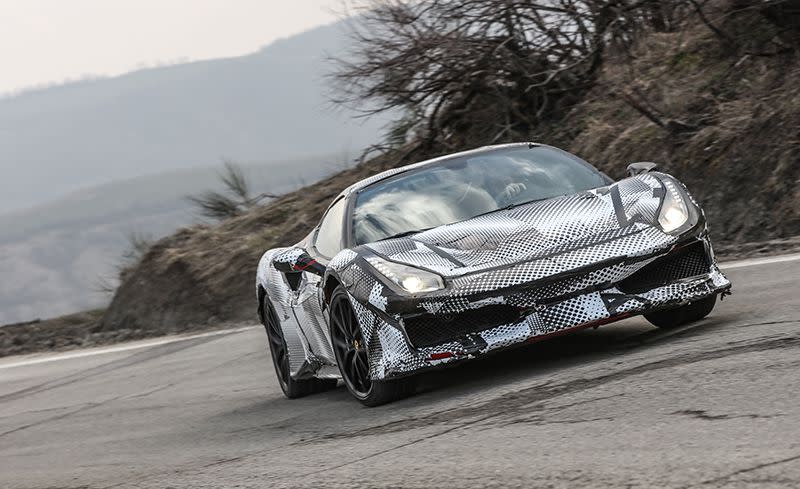The 2019 Ferrari 488 Pista Is Lighter, Louder, Spinnier, Slidier

“We were sort of scared,” says Vittorio Dini, Ferrari’s head of powertrain, when thinking back to the turbochargers that were appended to the automaker’s storied line of mid-engine V-8 screamers starting with the 488GTB. The fear, mostly, centered on responsiveness, that dastardly turbo lag might spoil the enviously desirable house that linear, rev-happy naturally aspirated V-8s had built. And, to be sure, this boosted engine did leave a few things behind. Maximum engine speed, for one, and, although what sound remained was the familiar tingly, hair-stand-on-end stuff, there was no mistaking that it had been muzzled.
With this heavily revised and 49-hp-stronger version of the twin-turbo 3.9-liter V-8 that powers the 488 Pista-Ferrari says that fully half of the engine’s part numbers are new-any earlier trepidation has vanished. Dini’s team were clearly given a very healthy budget and a mission to reduce weight and increase power by almost any means necessary, going far beyond a simple, crank-up-the-boost shortcut. Engine response was held sacrosanct and, in many cases, improved. Oh, and they also remedied the noise issue, as the Pista (which is Italian for “track”) is roughly twice as loud in the cabin as the 488GTB, according to Maranello.
Ferrari claims that the 710-hp Pista is nearly 200 pounds lighter overall, which would amount to a roughly 3250-pound curb weight-not quite as feathery as McLaren’s more carbon-fiber-intensive, and equally powerful, 720S. Many of the weight-saving items are familiar: The Pista gets a lithium-ion battery, thinner glass, plastic instead of glass for the rear hatch, less sound-deadening material, carbon-fiber front and rear bodywork, and Ferrari’s first carbon-fiber wheels, which are optional and save 22 pounds.
Why Don’t We Change Just About Everything?
The engine itself, code name F154CD, is Ferrari’s most powerful roadgoing V-8 ever and sheds an almost unbelievable 40 pounds via an extensive surgical whittling just about everywhere, with many of the changes first vetted on the 488 Challenge race car. Switching the exhaust manifolds, which are larger in diameter and have been dramatically reshaped, to Inconel alloy-long a Formula 1 go-to-saves 21 pounds. Titanium connecting rods shed about four pounds, and in turn, the crankshaft was reshaped to the tune of nearly three pounds due to the lessened counterbalancing needs. The cylinder liners are thinner and three pounds lighter, as engineers discovered they had built in more margin than needed on the 488, and the flywheel, with much larger-circumferential holes, is just over three pounds lighter. There’s also a number of smaller weight-saving contributors, including new valve springs and hollow intake valves, a slightly lighter air-conditioning compressor, and a carbon-fiber intake plenum with much shorter runners. Even the alternator cover switches from steel to aluminum to excise a quarter of a pound. The compression ratio nudges up from 9.4:1 to 9.6, the reprofiled camshafts provide one millimeter of additional valve lift for both the intake and exhaust valves, and the NGK iridium spark plugs dropped from two to one electrode. One thing that didn’t change is the IHI turbochargers themselves, although a speed sensor on each turbine wheel was added to precisely measure just how fast each one is twirling. Ferrari says this allows them to be spun roughly 6000 rpm faster than when their speed was being inferred, and the turbine wheels can now safely be pushed to within 1000 rpm of their maximum allowable speed. So peak boost does increase by 1.5 psi over that of the 488GTB, to 21.6 psi total.
The upside? Although the redline and power peak remain at 8000 rpm, rotating inertia is down 17 percent, and Ferrari claims the engine responds to throttle commands twice as quickly in many part-throttle situations, thanks in part to a new boost-control strategy. With moderate pedal in Race mode and above, the engine will actually keep the boost up but partially close the throttle plate to arrive at the requested speed and load point. That way, when the driver gets back on the accelerator, the boost is already there. Torque is up a nominal 7 lb-ft, and the additional 49 horses really start to show up above 5000 rpm. The engine is knock limited and calibrated on 98 RON fuel (about 93 AKI here in the United States); however, it will advance the timing by up to another 1.5 degrees to take advantage of higher octane fuel up to 102 RON (95 AKI).
Snow, CT-Off, and Sideways
The Pista will wear Michelin Pilot Sport Cup 2 tires, although a surprise snowstorm in Maranello on our drive day of nearly finished prototype Pistas led to a quick swap onto winter tires instead. Given the cold and wet conditions, we were shocked how quickly we got comfortable escalating to CT-Off (traction control off) mode and mindlessly sliding the car around Ferrari’s hallowed Pista di Fiorano track without fear of stuffing it. The latest generation of Ferrari’s Side Slip Angle Control system truly stays out of the way until it’s needed to save a spin. It allows as much as 30 degrees of slip angle, depending on vehicle speed and mostly on the rate of change of the car’s rotation. Ferrari’s chief test driver, Raffaele de Simone, reports that for the first time, the Pista’s quick lap, which is two seconds swifter around Fiorano than the 458 Speciale it replaces, was set in CT-Off rather than full-off mode. Top speed is up by 6 mph to a drag-limited 211 mph that’s achieved in seventh gear.
There’s no question that the much revised engine feels ultra responsive, even from 3000 or 4000 rpm, and there isn’t that follow-on surge of torque that’s typical of a high-boost turbocharged engine. That linearity is due both to the reduced reciprocating mass and new controls, as well as the modulated torque strategy that’s carried over from the 488, where the torque increases gradually with engine speed and gear, only reaching the actual peak-torque curve at 6750 rpm in each gear. The maximum torque-568 lb-ft at 3000 rpm-is possible only in seventh gear. As on the 488, this strategy makes it feel like the manic pull through each gear somehow gets stronger with every upshift. Its singular mission on our cold and wet day seemed to be to spin the rear tires to an early death, and obviously it was impossible to draw any conclusions about grip or turn-in.
However, we can confirm that aural involvement is way up, and the characteristic Ferrari V-8 flat-plane-crank warble is back to being ever present from behind the wheel. Cranking up the engine sound was largely a matter of letting more of it in the cabin; the vertical glass separating the cabin and the engine bay is thinner, and the sound-absorbing material has been reduced. Although the exhaust manifold has been reshaped to achieve a higher-pitched tone, the Pista exhales through the same muffler and is not substantially louder from outside the car.
Continuing the theme of change, the Pista’s engine no longer breathes through the side scoops but instead through new passages just ahead of the larger, fixed rear spoiler on either side, as on the 488 Challenge. That means it loses the GTB’s bifurcated scoops, which now primarily feed larger intercoolers. However, look closely and there’s still a small top section, which funnels air to the ignition coils to keep them from overheating. The angle of the front radiator is reversed so that air now exits down toward the road surface and away from the intercooler and air intakes. Ferrari says this change alone can reduce intake temperatures by almost four degrees Fahrenheit. There’s also the dramatic, cargo-volume-robbing plunge at the front end; incoming air bends up and over this S-shaped duct, which adds front-end downforce.
Bad Roads, Good Ride
As hard-edged and serious as the Pista is, it’s surprisingly compliant and shifts incredibly smoothly when just trundling around in traffic using a fraction of its capabilities. We couldn’t help but notice that Maranello’s roads are in a state of disrepair not too far from Detroit’s, which is no doubt having a positive effect on ride quality. Engaging bumpy-road mode (the button with the shock icon) yields a dramatic softening of the magnetorheological dampers. And even at relatively relaxed speeds, a satisfying amount of road texture filters up through the steering wheel.
The Getrag dual-clutch transaxle, which retains the same gear ratios, receives some additional internal fortification to survive the blindingly quick shift programming that, in max-attack mode, is slightly quicker than before. There’s also a new feature that adds an obnoxiously aggressive gut punch when downshifting in Race mode and above but only when the driver is braking far below the car’s capability. Experience that and you’ll know that Ferrari is calling you out as a wuss.
Overall, this kind of elaborate fiddling, particularly the obsessively extensive engine changes-Ferrari probably could have gotten away with much less-is what the company is all about. It’s also why Enzo himself insisted on complete end-to-end control of its engine building and why molten aluminum is still poured over sand molds in-house to manufacture the Pista’s crankcase, cylinder block, and heads. It’s a spectacular waypoint on the evolving turbocharged era.
You Might Also Like

 Yahoo Autos
Yahoo Autos 



